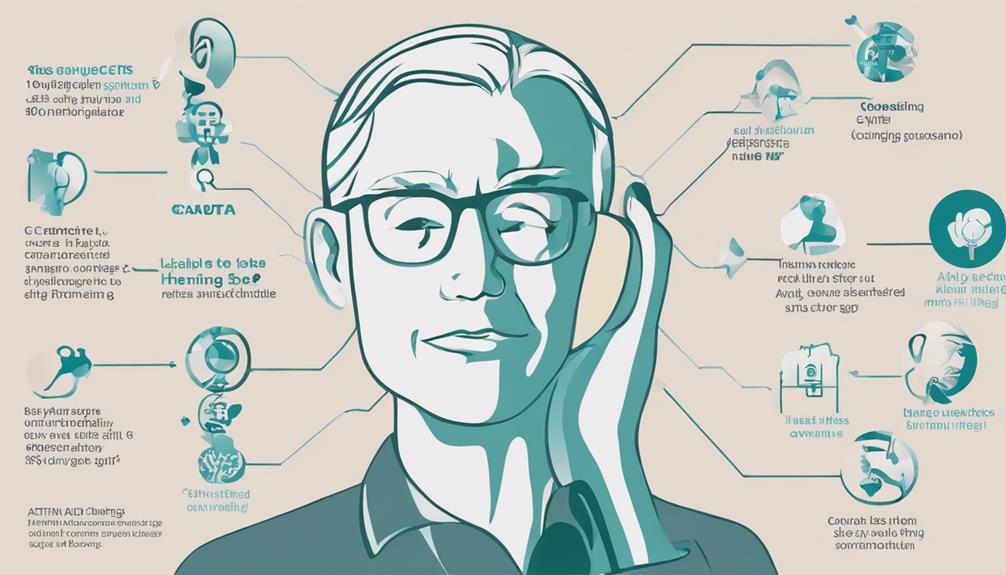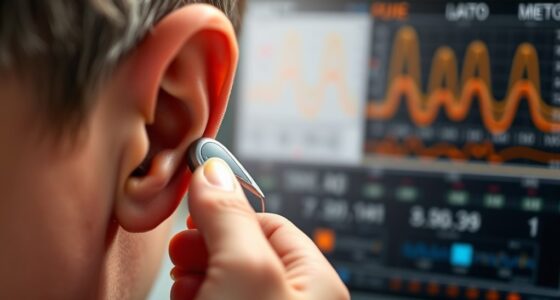Exploring the realm of health insurance may seem overwhelming, like a lost traveler in uncharted territory because of its intricate nature. But fear not, as Aetna’s hearing aid coverage is like a beacon of light waiting to be discovered.
Are you prepared to unveil the secrets that could potentially transform your auditory world?
Key Takeaways
- Understand Aetna's coverage criteria and plan options for hearing aids.
- Select the right hearing aids with consultation and consideration of features.
- Follow the step-by-step claim process accurately for reimbursement.
- Maximize benefits by utilizing in-network providers and proper documentation.
Aetna Hearing Aid Coverage Details
Our coverage details for hearing aids at Aetna encompass diagnostic evaluations and, in certain instances, the provision of hearing aids. Aetna's coverage for hearing aids is designed to assist individuals with documented hearing loss in accessing necessary devices.
Depending on the specific Aetna plan, coverage may extend to include the cost of hearing aids, subject to certain criteria such as referrals from physicians or meeting predefined hearing loss thresholds. It's essential to note that different Aetna plans may offer varying benefits related to hearing aids, potentially affecting coverage details.
Some plans may have separate benefits tailored specifically for hearing aids, impacting the extent of coverage provided. Additionally, individuals seeking coverage for hearing aids through Aetna should be aware that co-pays, deductibles, or other out-of-pocket costs might apply, necessitating a thorough review of the plan's details or consultation with Aetna representatives to understand the full scope of coverage available.
Understanding Aetna Plan Options

Understanding Aetna's plan options is crucial for individuals seeking comprehensive healthcare coverage, especially when considering coverage for services like hearing aids. Here are three key points to consider:
- Aetna Medicare Advantage Plans: Aetna offers a range of plan options, including Medicare Advantage plans that frequently include coverage for hearing aids. These plans typically provide a comprehensive approach to healthcare coverage.
- Plan Types: Aetna's plan options encompass various types such as HMO, HMO-POS, PPO, PFFS, and SNP plans. This variety caters to different needs and preferences, allowing individuals to select a plan that best suits their requirements.
- CMS Star Rating and Additional Benefits: Aetna's 2021 Medicare Advantage plans received a commendable 4 out of 5 stars from CMS, signifying high-quality and comprehensive coverage. Moreover, these plans offer additional benefits like prescription drug coverage, dental, vision, and hearing care, enhancing the overall healthcare experience for members.
Understanding these aspects of Aetna's plan options can help individuals make informed decisions when selecting the most suitable coverage for their healthcare needs.
How to Select the Right Hearing Aids
When selecting the right hearing aids, it's essential to consider factors such as your level of hearing loss and lifestyle needs to ensure optimal suitability.
Begin by consulting with an audiologist to determine the most suitable type based on your hearing loss level and personal preferences. Evaluate different hearing aid styles like in-the-ear, behind-the-ear, receiver-in-canal, completely-in-canal, or invisible-in-canal, considering features such as noise reduction, telecoil technology, rechargeability, and smartphone connectivity to align with your daily activities.
It's crucial to balance functionality and aesthetics by comparing size, comfort, visibility, and ease of use. During a trial period, test the hearing aids in various environments to assess their effectiveness in meeting your hearing improvement goals.
Step-by-Step Aetna Claim Process

In navigating the Aetna claim process for hearing aids, it's crucial to gather essential documentation such as audiologist prescriptions and purchase receipts to initiate reimbursement procedures. Here are three key steps to help you through the Aetna claim process:
- Check Coverage Eligibility: Review your plan details to ensure your hearing aids are covered. Some plans may require prior authorization for specific services to guarantee coverage eligibility.
- Submit Claims Promptly: Follow the instructions provided by Aetna to submit your claims accurately and on time. This will help expedite the claim process and increase the chances of receiving reimbursement for your covered hearing aid costs.
- Include Required Documentation: Make sure to include all necessary paperwork when submitting your claim. This typically includes audiologist prescriptions, purchase receipts, and any other documentation requested by Aetna to support your claim for hearing aid reimbursement.
Maximizing Aetna Hearing Aid Benefits
To maximize Aetna's hearing aid benefits, individuals should proactively explore coverage options and requirements to make informed decisions about their hearing health. Aetna's coverage for hearing aids under Medicare Advantage plans can extend up to 80% of the total cost, with reimbursement reaching a maximum of $1,000 per aid for qualifying hearing loss when services are obtained from in-network providers. However, it's essential to note that additional costs such as batteries or repairs are typically not included in the coverage. To ensure smooth reimbursement processes, keeping detailed documentation and receipts of all related expenses is crucial. This documentation will serve as evidence for any potential reimbursement claims and help individuals navigate the process more efficiently. By understanding the coverage limits, requirements, and necessary documentation, individuals can fully utilize Aetna's hearing aid benefits and prioritize their hearing health effectively.
| Aspect | Details |
|---|---|
| Coverage Percentage | Up to 80% under Medicare Advantage plans |
| Maximum Reimbursement | $1,000 per aid for qualifying hearing loss |
| In-Network Providers | Services must be obtained from in-network providers |
| Additional Costs | Costs like batteries or repairs are not typically covered |
Frequently Asked Questions
How Often Does Aetna Pay for Hearing Aids?
We usually cover hearing aids every 3-5 years, based on your plan and needs. Coverage can be a set dollar amount per aid or a percentage of the total cost, up to a limit.
Some plans might need prior authorization or a detailed assessment to decide how often you're covered. It's crucial to check your plan's terms and limits for specifics. Knowing this helps you plan and budget for any additional costs.
Why Are Hearing Aids Not Covered by Insurance?
Hearing aids are often not covered by insurance due to the high cost associated with these devices. Insurance companies may view hearing aids as elective or cosmetic rather than essential medical equipment. This can lead to limitations on coverage to manage costs.
The absence of mandated coverage for hearing aids in insurance plans contributes to the financial burden faced by individuals with hearing loss.
Are Bone Anchored Hearing Aids Covered by Insurance?
Yes, bone anchored hearing aids may be covered by insurance, including Aetna, if deemed medically necessary. Coverage typically requires evaluation by an audiologist or otolaryngologist. Aetna may cover such devices for various hearing conditions. Prior authorization and medical necessity documentation are usually needed.
Understanding Aetna's policy on Bone Anchored Hearing Aids is key for those seeking this solution. Contacting Aetna directly can provide specific information on coverage eligibility.
What Is the Modifier 52 for Aetna?
We understand the importance of clarity when it comes to medical billing.
Modifier 52 is utilized when a service is partially reduced or not completed due to unforeseen circumstances, still warranting some payment adjustment. Aetna recognizes this modifier and adjusts reimbursements accordingly.
Accurate documentation of Modifier 52 in medical records is crucial for billing accuracy. Mastering its use ensures proper reimbursement for services that were partially rendered.
Conclusion
In conclusion, navigating Aetna's coverage for hearing aids can feel like dancing through a symphony of options and benefits.
By understanding the process, selecting the right aids, and maximizing your benefits, you can harmonize your hearing health with ease.
Let Aetna be your conductor, guiding you towards a clearer, more vibrant quality of life.











